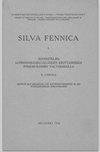Palatability of Norway spruce needles infected with Lophodermium piceae to larvae of two sawfly species
IF 1.8
3区 农林科学
Q2 FORESTRY
引用次数: 0
Abstract
Unequivocal evidence on the antagonistic effects of endophytic fungi associated with woody plants against insect herbivores has been documented in only a few cases so far. Experimental evidence of the significance of needle endophytes to coniferous trees has remained scant because it is difficult to obtain trees with needles free of endophytes that could be used as comparable controls for trees infected with endophytes. Previously we reported a new methodology to get Norway spruce (Picea abies (L.) Karst.) saplings without needle endophytes and to inoculate them with a needle endophyte Lophodermium piceae (Fuckel) Höhn. Here we describe the first trial where spruce saplings with and without needle endophytes were provided as substrate for insect larvae. We transferred larvae of two sawfly species, Neodiprion sertifer Geoffroy and Gilpina pallida Klug, to the seedlings. Even though the main host of these sawfly species is not Norway spruce, but Scots pine (Pinus sylvestris L.), they are also known to occasionally feed on spruce. In this experiment the larvae did not develop to pupae with the provided spruce substrate but consumed measurable amounts of needles. No significant difference was found between the extent of needles consumed by either of the two sawfly species in inoculated and uninoculated saplings.两种锯蝇侵染挪威云杉针叶的适口性
关于木本植物内生真菌对昆虫食草动物的拮抗作用的明确证据迄今仅在少数案例中得到记录。针叶内生菌对针叶树的重要性的实验证据仍然很少,因为很难获得没有内生菌的针叶树木,这些树木可以用作感染内生菌的树木的可比对照。以前我们报道了一种新的方法获得挪威云杉(Picea abies (L.))。喀斯特(岩溶)幼树,没有针状内生菌,并用针状内生菌Lophodermium piceae (Fuckel) Höhn接种它们。在这里,我们描述了第一次试验,其中云杉树苗有针状内生菌和没有针状内生菌作为昆虫幼虫的基质。我们将两种锯蝇(Neodiprion sertifer Geoffroy)和Gilpina pallida Klug)的幼虫转移到幼苗上。尽管这些锯蝇的主要宿主不是挪威云杉,而是苏格兰松(Pinus sylvestris L.),但它们偶尔也以云杉为食。在这个实验中,幼虫没有在提供的云杉基质上发育成蛹,但消耗了可测量数量的针叶。两种锯蝇对接种苗和未接种苗的针叶消耗程度无显著差异。
本文章由计算机程序翻译,如有差异,请以英文原文为准。
求助全文
约1分钟内获得全文
求助全文
来源期刊

Silva Fennica
农林科学-林学
CiteScore
3.50
自引率
11.10%
发文量
21
审稿时长
3 months
期刊介绍:
Silva Fennica publishes significant new knowledge on forest sciences. The scope covers research on forestry and forest ecosystems. Silva Fennica aims to increase understanding on forest ecosystems, and sustainable use and conservation of forest resources. Use of forest resources includes all aspects of forestry containing biomass-based and non-timber products, economic and social factors etc.
 求助内容:
求助内容: 应助结果提醒方式:
应助结果提醒方式:


